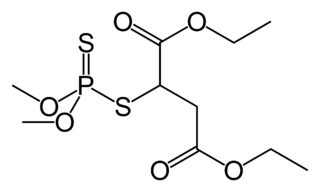
Vinegar is an aqueous solution of acetic acid and trace compounds that may include flavorings. Vinegar typically contains from 5% to 8% acetic acid by volume. Usually, the acetic acid is produced by a double fermentation, converting simple sugars to ethanol using yeast, and ethanol to acetic acid using acetic acid bacteria. Many types of vinegar are made, depending on source materials. The product is now mainly used in the culinary arts as a flavorful, acidic cooking ingredient, or in pickling. Various types are used as condiments or garnishes, including balsamic vinegar and malt vinegar.

Threonine is an amino acid that is used in the biosynthesis of proteins. It contains an α-amino group, a carboxyl group, and a side chain containing a hydroxyl group, making it a polar, uncharged amino acid. It is essential in humans, meaning the body cannot synthesize it: it must be obtained from the diet. Threonine is synthesized from aspartate in bacteria such as E. coli. It is encoded by all the codons starting AC.
Unsupervised learning is a method in machine learning where, in contrast to supervised learning, algorithms learn patterns exclusively from unlabeled data. The hope is that through mimicry, which is an important mode of learning in people, the machine is forced to build a concise representation of its world and then generate imaginative content from it.

Winemaking or vinification is the production of wine, starting with the selection of the fruit, its fermentation into alcohol, and the bottling of the finished liquid. The history of wine-making stretches over millennia. There are authentic proofs that suggest that the earliest Wine production took place in Georgia and Iran around 6000 to 5000 B.C. The science of wine and winemaking is known as oenology. A winemaker may also be called a vintner. The growing of grapes is viticulture and there are many varieties of grapes.

Fruit wines are fermented alcoholic beverages made from a variety of base ingredients ; they may also have additional flavors taken from fruits, flowers, and herbs. This definition is sometimes broadened to include any alcoholic fermented beverage except beer. For historical reasons, mead, cider, and perry are also excluded from the definition of fruit wine.

Cider apples are a group of apple cultivars grown for their use in the production of cider. Cider apples are distinguished from "cookers" and "eaters", or dessert apples, by their bitterness or dryness of flavour, qualities which make the fruit unpalatable but can be useful in cidermaking. Some apples are considered to occupy more than one category.

Malathion is an organophosphate insecticide which acts as an acetylcholinesterase inhibitor. In the USSR, it was known as carbophos, in New Zealand and Australia as maldison and in South Africa as mercaptothion.

White wine is a wine that is fermented without skin contact. The colour can be straw-yellow, yellow-green, or yellow-gold. It is produced by the alcoholic fermentation of the non-coloured pulp of grapes, which may have a skin of any colour. White wine has existed for at least 4,000 years.

Malolactic conversion is a process in winemaking in which tart-tasting malic acid, naturally present in grape must, is converted to softer-tasting lactic acid. Malolactic fermentation is most often performed as a secondary fermentation shortly after the end of the primary fermentation, but can sometimes run concurrently with it. The process is standard for most red wine production and common for some white grape varieties such as Chardonnay, where it can impart a "buttery" flavor from diacetyl, a byproduct of the reaction.

Amitraz is a non-systemic acaricide and insecticide and has also been described as a scabicide. It was first synthesized by the Boots Co. in England in 1969. Amitraz has been found to have an insect repellent effect, works as an insecticide and also as a pesticide synergist. Its effectiveness is traced back on alpha-adrenergic agonist activity, interaction with octopamine receptors of the central nervous system and inhibition of monoamine oxidases and prostaglandin synthesis. Therefore, it leads to overexcitation and consequently paralysis and death in insects. Because amitraz is less harmful to mammals, amitraz is among many other purposes best known as insecticide against mite- or tick-infestation of dogs. It is also widely used in the beekeeping industry as a control for the Varroa destructor mite, although there are recent reports of resistance.
Neural network software is used to simulate, research, develop, and apply artificial neural networks, software concepts adapted from biological neural networks, and in some cases, a wider array of adaptive systems such as artificial intelligence and machine learning.

Bordeaux mixture (also called Bordo Mix) is a mixture of copper(II) sulphate (CuSO4) and quicklime (CaO) used as a fungicide. It is used in vineyards, fruit-farms and gardens to prevent infestations of downy mildew, powdery mildew and other fungi. It is sprayed on plants as a preventive treatment; its mode of action is ineffective after a fungus has become established. It was invented in the Bordeaux region of France in the late 19th century. If it is applied in large quantities annually for many years, the copper in the mixture eventually becomes a pollutant. As such its use is illegal in most of the European Union. Despite this, it has been promoted as an 'organic' pesticide.

The following outline is provided as an overview of and topical guide to wine:
Patulin is an organic compound classified as a polyketide. It is a white powder soluble in acidic water and in organic solvents. It is a lactone that is heat-stable, so it is not destroyed by pasteurization or thermal denaturation. However, stability following fermentation is lessened. It is a mycotoxin produced by a variety of molds, in particular, Aspergillus and Penicillium and Byssochlamys. Most commonly found in rotting apples, the amount of patulin in apple products is generally viewed as a measure of the quality of the apples used in production. In addition, patulin has been found in other foods such as grains, fruits, and vegetables. Its presence is highly regulated.

Intensive animal farming, industrial livestock production, and macro-farms, also known as factory farming, is a type of intensive agriculture, specifically an approach to animal husbandry designed to maximize production while minimizing costs. To achieve this, agribusinesses keep livestock such as cattle, poultry, and fish at high stocking densities, at large scale, and using modern machinery, biotechnology, and global trade. The main products of this industry are meat, milk and eggs for human consumption. There are issues regarding whether intensive animal farming is sustainable in the social long-run given its costs in resources. Analysts also raise issues about its ethics.

Alexey Ivakhnenko was a Soviet and Ukrainian mathematician most famous for developing the group method of data handling (GMDH), a method of inductive statistical learning, for which he is sometimes referred to as the "Father of deep learning".
Group method of data handling (GMDH) is a family of inductive algorithms for computer-based mathematical modeling of multi-parametric datasets that features fully automatic structural and parametric optimization of models.

Pesticide application refers to the practical way in which pesticides are delivered to their biological targets. Public concern about the use of pesticides has highlighted the need to make this process as efficient as possible, in order to minimise their release into the environment and human exposure. The practice of pest management by the rational application of pesticides is supremely multi-disciplinary, combining many aspects of biology and chemistry with: agronomy, engineering, meteorology, socio-economics and public health, together with newer disciplines such as biotechnology and information science.

Cider is an alcoholic beverage made from the fermented juice of apples. Cider is widely available in the United Kingdom and the Republic of Ireland. The UK has the world's highest per capita consumption, as well as the largest cider-producing companies. Ciders from the South West of England are generally higher in alcoholic content. Cider is also popular in many Commonwealth countries, such as India, South Africa, Canada, Australia, and New Zealand. As well as the UK and its former colonies, cider is popular in Portugal, France, Friuli, and northern Spain. Germany also has its own types of cider with Rhineland-Palatinate and Hesse producing a particularly tart version known as Apfelwein. In the U.S. and Canada, varieties of alcoholic cider are often called hard cider to distinguish it from non-alcoholic apple cider or "sweet cider", also made from apples. In Canada, cider cannot contain less than 2.5% or over 13% absolute alcohol by volume.
Adulteration is a legal offense and when the food fails to meet the legal standards set by the government, it is said to have been Adulterated Food. One form of adulteration is the addition of another substance to a food item in order to increase the quantity of the food item in raw form or prepared form, which results in the loss of the actual quality of the food item. These substances may be either available food items or non-food items. Among meat and meat products some of the items used to adulterate are water or ice, carcasses, or carcasses of animals other than the animal meant to be consumed. In the case of seafood, adulteration may refer to species substitution (mislabeling), which replaces the species identified on the product label with another species, or undisclosed processing methods, in which treatments such as additives, excessive glazing, or short-weighting are not disclosed to the consumer.














